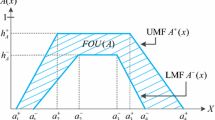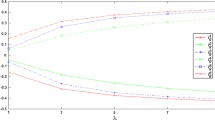Abstract
The aim of this paper is to develop a likelihood-based QUALIFLEX method with interval type-2 fuzzy sets for multiple criteria decision analysis. This paper considers the context of interval type-2 trapezoidal fuzzy numbers and also introduces an extended concept of likelihoods of interval type-2 fuzzy preference relations. The concepts of lower and upper likelihoods are presented to serve as lower and upper bounds, respectively, of the possibility of preference relations and then to determine the likelihoods between interval type-2 trapezoidal fuzzy numbers. This paper uses a likelihood-based comparison between evaluative ratings to propose the concepts of concordance indices and comprehensive concordance indices for evaluating the permutations of alternatives corresponding to criterion-by-criterion consistency. By employing the signed distance-based method or the optimal membership-degree-determination method, the best permutation and its corresponding optimal ranking order of the alternatives can be acquired through a comparison of all of the comprehensive concordance indices. The applicability and effectiveness of the proposed method are illustrated with a medical decision-making problem that addresses the selection of treatment options. Additionally, a comparative analysis is performed with some relevant multiple criteria decision-making methods to demonstrate the advantages of the likelihood-based QUALIFLEX method. Finally, an analysis through computational experiments is conducted to examine the implementation efficiency of the proposed method.



Similar content being viewed by others
References
Baležentis T, Zeng S (2013) Group multi-criteria decision making based upon interval-valued fuzzy numbers: an extension of the MULTIMOORA method. Expert Syst Appl 40(2):543–550
Castillo O, Melin P (2012) Optimization of type-2 fuzzy systems based on bio-inspired methods: a concise review. Inform Sci 205:1–19
Castillo O, Melin P, Pedrycz W (2011) Design of interval type-2 fuzzy models through optimal granularity allocation. Appl Soft Comput 11(8):5590–5601
Chen T-Y (2011a) An integrated approach for assessing criterion importance with interval type-2 fuzzy sets and signed distances. J Chin Inst Ind Eng 28(8):553–572
Chen T-Y (2011b) Signed distanced-based TOPSIS method for multiple criteria decision analysis based on generalized interval-valued fuzzy numbers. Int J Inform Technol Decis Making 10(6):1131–1159
Chen T-Y (2012) Multiple criteria group decision-making with generalized interval-valued fuzzy numbers based on signed distances and incomplete weights. Appl Math Model 36(7):3029–3052
Chen T-Y (2013a) An interactive method for multiple criteria group decision analysis based on interval type-2 fuzzy sets and its application to medical decision making. Fuzzy Optim Decis Making 12(3):323–356
Chen T-Y (2013b) A signed-distance-based approach to importance assessment and multi-criteria group decision analysis based on interval type-2 fuzzy set. Knowl Inform Syst 35(1):193–231
Chen T-Y (2013c) A linear assignment method for multiple-criteria decision analysis with interval type-2 fuzzy sets. Appl Soft Comput 13(5):2735–2748
Chen T-Y (2013d) Data construction process and QUALIFLEX-based method for multiple-criteria group decision making with interval-valued intuitionistic fuzzy sets”. Int J Inform Technol Decis Making 12(3):425–467
Chen T-Y (2014a) Interval-valued intuitionistic fuzzy QUALIFLEX method with a likelihood-based comparison approach for multiple criteria decision analysis. Inform Sci 261:149–169
Chen T-Y (2014b) An ELECTRE-based outranking method for multiple criteria group decision making using interval type-2 fuzzy sets. Inform Sci 263:1–21
Chen T-Y, Chang C-H, Lu J-FR (2013) The extended QUALIFLEX method for multiple criteria decision analysis based on interval type-2 fuzzy sets and applications to medical decision making. Eur J Oper Res 226(3):615–625
Chen S-M, Chen J-H (2009) Fuzzy risk analysis based on similarity measures between interval-valued fuzzy numbers and interval-valued fuzzy number arithmetic operators. Expert Syst Appl 36(3–2):6309–6317
Chen S-M, Lee L-W (2010a) Fuzzy multiple attributes group decision-making based on the ranking values and the arithmetic operations of interval type-2 fuzzy sets. Expert Syst Appl 37(1):824–833
Chen S-M, Lee L-W (2010b) Fuzzy multiple criteria hierarchical group decision-making based on interval type-2 fuzzy sets. IEEE Trans Syst Man Cybern Part A Syst Hum 40(5):1120–1128
Chen S-M, Lee L-W (2010c) Fuzzy decision-making based on likelihood-based comparison relations. IEEE Trans Fuzzy Syst 18(3):613–628
Chen T-Y, Tsui C-W (2012) Intuitionistic fuzzy QUALIFLEX method for optimistic and pessimistic decision making. Adv Inform Sci Serv Sci 4(14):219–226
Chen T-Y, Wang J-C (2009) Interval-valued fuzzy permutation method and experimental analysis on cardinal and ordinal evaluations. J Comput Syst Sci 75(7):371–387
Chen S-M, Wang C-Y (2013) Fuzzy decision making systems based on interval type-2 fuzzy sets. Inform Sci 242:1–21
Chen T-Y, Wang J-C, Tsui C-W (2007) Decision model with permutation methods based on intuitionistic fuzzy sets. In: Proceedings of the 8th Asia Pacific Industrial Engineering and Management System and 2007 Chinese Institute of Industrial Engineers Conference (APIEMS and CIIE 2007), pp 243–250
Greco S, Kadziński M, Mousseau V, Słowiński R (2011) ELECTRE\(^{{\rm GKMS}}\): robust ordinal regression for outranking methods. Eur J Oper Res 214(1):118–135
Greenfield S, Chiclana F, Coupland S, John R (2009) The collapsing method of defuzzification for discretised interval type-2 fuzzy sets. Inform Sci 179(13):2055–2069
Griffith DA, Paelinck JHP (2011) Qualireg, a qualitative regression method. Adv Geogr Inform Sci 1(2):227–233
Hidalgo D, Castillo O, Melin P (2009) Type-1 and type-2 fuzzy inference systems as integration methods in modular neural networks for multimodal biometry and its optimization with genetic algorithms. Inform Sci 179(13):2123–2145
Hokkanen J, Lahdelma R, Salminen P (2000) Multicriteria decision support in a technology competition for cleaning polluted soil in Helsinki. J Environ Manage 60(4):339–348
Lahdelma R, Miettinen K, Salminen P (2003) Ordinal criteria in stochastic multicriteria acceptability analysis (SMAA). Eur J Oper Res 147(1):117–127
Lee L-W, Chen S-M (2009) A new method for fuzzy decision-making based on likelihood-based comparison relations. In: Proceedings of the Eighth International Conference on Machine Learning and Cybernetics, Baoding, China, July 12–15 2009, pp 3021–3025
Li D-F (2010a) Linear programming method for MADM with interval-valued intuitionistic fuzzy sets. Expert Syst Appl 37(8):5939–5945
Li D-F (2010b) TOPSIS-based nonlinear-programming methodology for multiattribute decision making with interval-valued intuitionistic fuzzy sets. IEEE Trans Fuzzy Syst 18(2):299–311
Li D-F (2011) Closeness coefficient based nonlinear programming method for interval-valued intuitionistic fuzzy multiattribute decision making with incomplete preference information. Appl Soft Comput 11(4):3402–3418
Li D-F, Wang Y-C, Liu S, Shan F (2009) Fractional programming methodology for multi-attribute group decision-making using IFS. Appl Soft Comput 9(1):219–225
Martel J-M, Matarazzo B (2005) Other outranking approaches. In: Figueira J, Greco S, Ehrgott M (eds) Multiple criteria decision analysis: state of the art surveys. Springer Science+Business Media, New York, pp 197–262
Melin P, Castillo O (2013) A review on the applications of type-2 fuzzy logic in classification and pattern recognition. Expert Syst Appl 40(13):5413–5423
Mendel JM (2010) Type-2 fuzzy sets: a tribal parody. IEEE Comput Intell Mag 5(4):24–27
Ngan S-C (2013) A type-2 linguistic set theory and its application to multi-criteria decision making. Comput Ind Eng 64(2):721–730
Paelinck JHP (1976) Qualitative multiple criteria analysis, environmental protection and multiregional development. Pap Reg Sci Assoc 36(1):59–74
Paelinck JHP (1977) Qualitative multicriteria analysis: an application to airport location. Environ Plann 9(8):883–895
Paelinck JHP (1978) QUALIFLEX: a flexible multiple-criteria method. Econ Lett 1(3):193–197
Sarabando P, Dias LC (2010) Simple procedures of choice in multicriteria problems without precise information about the alternatives’ values. Comput Oper Res 37(12):2239–2247
Vahdani B, Hadipour H (2011) Extension of the ELECTRE method based on interval-valued fuzzy sets. Soft Comput 15(3):569–579
Vahdani B, Jabbari AHK, Roshanaei V, Zandieh M (2010) Extension of the ELECTRE method for decision-making problems with interval weights and data. Inte J Adv Manufact Technol 50(5–8):793 –800
Wang W, Liu X, Qin Y (2012) Multi-attribute group decision making models under interval type-2 fuzzy environment. Knowl-Based Syst 30:121–128
Wu D, Mendel JM (2007) Uncertainty measures for interval type-2 fuzzy sets. Inform Sci 177(23):5378–5393
Zadeh LA (1975) The concept of a linguistic variable and its application to approximate reasoning-I. Inform Sci 8(3):199–249
Zhang Z (2013a) On characterization of generalized interval type-2 fuzzy rough sets. Inform Sci 219:124–150
Zhang N (2013b) Method for aggregating correlated interval grey linguistic variables and its application to decision making. Technol Econ Dev Econ 19(2):189–202
Zhang X, Jin F, Liu P (2013) A grey relational projection method for multi-attribute decision making based on intuitionistic trapezoidal fuzzy number. Appl Math Model 37(5):3467–3477
Zhang Z, Zhang S (2013) A novel approach to multi attribute group decision making based on trapezoidal interval type-2 fuzzy soft sets. Appl Math Model 37(7):4948–4971
Zhao T, Xiao J (2014) General type-2 fuzzy rough sets based on \(\alpha \)-plane representation theory. Soft Comput 18(2):227–237
Acknowledgments
The authors are very grateful to the respected editor and the anonymous referees for their insightful and constructive comments, which helped to improve the overall quality of the paper. The authors are grateful for the grant funding support of the Taiwan Ministry of Science and Technology (MOST 102-2410-H-182-013-MY3) during which the study was completed.
Author information
Authors and Affiliations
Corresponding author
Additional information
Communicated by V. Loia.
Electronic supplementary material
Below is the link to the electronic supplementary material.
Rights and permissions
About this article
Cite this article
Wang, JC., Tsao, CY. & Chen, TY. A likelihood-based QUALIFLEX method with interval type-2 fuzzy sets for multiple criteria decision analysis. Soft Comput 19, 2225–2243 (2015). https://doi.org/10.1007/s00500-014-1404-8
Published:
Issue Date:
DOI: https://doi.org/10.1007/s00500-014-1404-8




